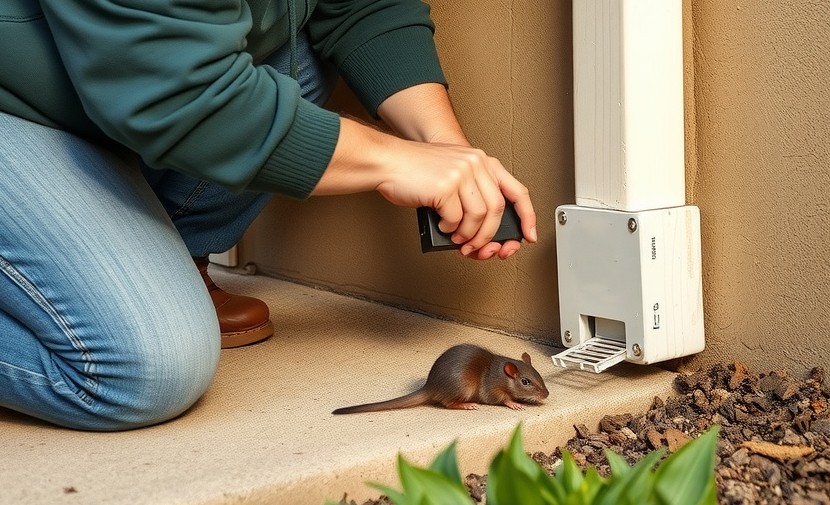California has some of the nation’s toughest laws when it comes to pest control—and for good reason. The state’s diverse wildlife, dense urban areas, and large agricultural sector make balancing public health with environmental safety especially challenging. One major focus has been limiting the use of harmful anticoagulant rodenticides, which for decades were the go-to solution for controlling rats and mice.
This post explains why California’s strict rodenticide laws were passed, what they mean for homeowners, and how safe alternatives can still solve a serious rodent infestation.
Why California Restricted Rodenticides
For years, both first generation anticoagulant rodenticides and second generation anticoagulant rodenticides were common tools in the fight against rodents. These rodenticide products contain toxic active ingredients like brodifacoum and bromadiolone, which prevent blood clotting and cause death after ingestion.
The problem? Poisoned rodents rarely die right away. Instead, they may wander outdoors where predators and other wildlife—like mountain lions, coyotes, hawks, or the northern spotted owl—may eat poisoned rodents. This leads to secondary poisoning, spreading toxins throughout the food chain.
In addition, pets and even humans face risks from accidental exposure. Reports from the California Department of Fish and Wildlife and the Department of Pesticide Regulation found widespread contamination in non-target species.
As a result, lawmakers—including Governor Gavin Newsom, who signed the Poison Free Wildlife Act (Assembly Bill 1788) in 2020—moved to restrict these dangerous chemicals to protect public health and sensitive species.
What the Poison Free Wildlife Act Means
Under the Poison Free Wildlife Act, the use of second generation anticoagulant rodenticides is banned in most settings. These chemicals are now considered restricted materials, meaning only limited, specific uses are allowed—such as for certain agricultural activities or conveyance facilities like shipping ports.
For homeowners in California, this means:
- You cannot purchase or use SGARs (second generation products) for residential rodent control.
- Licensed pest control companies must adopt alternatives that emphasize safety and reduce risks to wildlife.
- Enforcement is handled by local and state public health officers, along with the California Department of Pesticide Regulation.
While some worry that these restrictions lead to higher costs, the reality is that they prevent devastating harm to wildlife, pets, and even people.
First vs. Second Generation Anticoagulant Rodenticides
It helps to understand the difference between the two classes of anticoagulant rodenticides:
- First generation anticoagulant rodenticides (FGARs): Require multiple feedings to be lethal. Examples include warfarin and chlorophacinone.
- Second generation anticoagulant rodenticides (SGARs): Much more toxic, often lethal after a single feeding, and remain in animal tissue for long periods. Examples include brodifacoum and bromadiolone.
Both pose risks, but SGARs are far more dangerous because they stay in the ecosystem longer, making secondary poisoning of non-targeted wildlife and other animals much more likely.
The Role of Public Health and Regulation
The law assigns oversight to both state and local officials. The state public health officer and each local public health officer must ensure compliance with new rules. The Department of Pesticide Regulation also enforces safe use of pesticides across California.
Together, these agencies aim to protect public health, reduce environmental contamination, and ensure pest control companies adopt safer strategies.
Risks of Poisoned Rodents
The biggest concern is not just the poisoned rodents themselves, but what happens afterward:
- Wildlife such as owls, hawks, coyotes, or mountain lions may eat poisoned rodents, leading to secondary poisoning.
- Pets can also be harmed by finding and eating a sick rodent.
- Even humans are at risk through accidental contact with rodenticide products.
Because of these dangers, California law prioritizes non-toxic rodent control methods first.
Alternatives for Rodent Control
If poisons are restricted, how can homeowners still protect their property? The answer lies in safer, smarter approaches.
1. Integrated Pest Management (IPM)
Integrated pest management is now the gold standard in pest management. It includes:
- Sealing entry points to block rodents from gaining access to structures
- Removing food sources, clutter, and nesting materials
- Using mechanical traps instead of toxic baits
2. Traps
Snap traps, electronic traps, and live traps remain effective tools for controlling rats and mice without endangering wildlife.
3. Exclusion and Prevention
Caulking cracks, trimming vegetation, and storing food properly make homes less attractive to rodents and other pests.
4. Professional Help
Licensed pest control companies trained in current law can design solutions tailored to each pest problem, balancing safety and effectiveness.
The Cost Factor
Some homeowners worry about higher costs for poison-free methods. While upfront prices for traps or exclusion services may be more than a bag of poison, they prevent bigger problems like property damage, poisoned pets, or harm to protected wildlife. Over time, safer methods are a smarter investment.
Protecting Wildlife While Protecting Homes
California’s approach highlights the need to protect both public health and native wildlife. By limiting harmful anticoagulant rodenticides, the state reduces risks to species like the northern spotted owl and mountain lions, while still allowing homeowners to manage rodent infestations.
This balance ensures that while rodents are kept in check, ecosystems remain healthier, and residents can trust that their communities are safer.
Staying Compliant and Effective
California’s strict rodenticide laws are designed to protect public health, prevent secondary poisoning, and preserve vulnerable wildlife. While these restrictions change how homeowners and pest control companies handle rodent control, effective alternatives exist.
Through integrated pest management, the use of traps, and professional guidance, residents can still keep their homes free from rats, mice, and other rodents—without endangering pets, people, or the environment.
Call Insight Pest Management Today
At Insight Pest Management, we understand the challenges of dealing with a rodent infestation under today’s strict California law. Our team uses safe, modern pest management strategies that comply with the Poison Free Wildlife Act, protect your home, and keep your family safe.
Call us today at (805) 628-2881 to schedule a consultation and learn about non-toxic, effective rodent control solutions.


